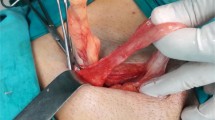Abstract
Background
Herniation of retroperitoneal adipose tissue into the inguinal canal, traditionally called cord lipoma, is frequently encountered during endoscopic totally extraperitoneal inguinal hernioplasty (TEP). Failure to recognize and manage the cord lipoma accounted for 30%–50% of recurrent hernia after TEP. The present study was undertaken to evaluate the incidence, risk factors, and management of herniated retroperitoneal adipose tissue during TEP.
Methods
Between December 2002 and November 2005 all patients who underwent TEP were prospectively evaluated for the presence of cord lipoma. Clinical outcomes of patients who were treated for their cord lipoma were compared with those without cord lipoma. Risk factors for the occurrence of cord lipoma were also examined.
Results
A total of 498 patients underwent unilateral (n = 386) or bilateral (n = 112) TEP. The overall incidence of cord lipoma was 26.5% (n = 132). A higher body weight, a higher body mass index, and a larger hernial defect were significantly associated with the presence of cord lipoma. Most of the cord lipoma cases (n = 119) were reduced to pelvic peritoneal reflection line after division of the feeding vessels from surrounding structures, while the rest (n = 13) were resected. Early postoperative outcomes, including pain score, morbidities, and other recovery variables, showed no significant difference between the two groups. No recurrence occurred in the present series.
Conclusions
Herniation of retroperitoneal adipose tissue into the inguinal canal occurred in more than one-fifth of the patients with inguinal hernia. Awareness and appropriate treatment of the cord lipoma helped to reduce the risk of recurrence. During TEP, the internal inguinal ring and inguinal canal should always be cleared of any herniated adipose tissue by either reduction or resection. This clearing posed no adverse effects on postoperative outcome.




Similar content being viewed by others
References
Carilli S, Alper A, Emre A (2004) Inguinal cord lipomas. Hernia 8: 252–254
Crawford DL, Hiatt JR, Phillips EH (1998) Laparoscopy identifies unexpected groin hernias. Am Surg 64: 976–978
De Luca L, Di Giorgio P, Signoriello G, Sorrentino E, Rivellini G, D’Amore E, De Luca B, Murray JA (2004) Relationship between hiatal hernia and inguinal hernia. Dig Dis Sci 49: 243–247
Fawcett AN, Rooney PS (1997) Inguinal cord lipoma. Br J Surg 84: 1169
Felix E, Scott S, Crafton B, Geis P, Duncan T, Sewell R, McKernan B (1998) Causes of recurrence after laparoscopic hernioplasty. A multicenter study. Surg Endosc 12: 226–231
Gersin KS, Heniford BT, Garcia-Ruiz A, Ponsky JL (1999) Missed lipoma of the spermatic cord. A pitfall of transabdominal preperitoneal laparoscopic hernia repair. Surg Endosc 13: 585–587
Hainsworth PJ (2000) A hernia sac cannot be found at operation [letter]. Br J Surg 87: 521
Heller CA, Marucci DD, Dunn T, Barr EM, Houang M, Dos Remedios C (2002) Inguinal canal “lipoma”. Clin Anat 15: 280–285
Lau H (2005) Fibrin sealant versus mechanical stapling for mesh fixation during endoscopic extraperitoneal inguinal hernioplasty: a randomized prospective trial. Ann Surg 242: 670–675
Lau H (2004) Sliding lipoma: an indirect inguinal hernia without a peritoneal sac. J Laparoendosc Surg Adv Surg Tech A 14: 57–59
Lilly MC, Arregui ME (2002) Lipomas of the cord and round ligament. Ann Surg 235: 586–590
McDonnell CO, Walsh TN (2000) A hernia sac cannot be found at operation [letter]. Br J Surg 87: 521
Nasr AO, Tormey S, Walsh TN (2005) Lipoma of the cord and round ligament: an overlooked diagnosis? Hernia 9: 245–247
Nyhus LM (1993) Individualization of hernia repair: a new era. Surgery 114: 1–2
Read RC, Schaefer RF (2000) Lipoma of the spermatic cord, fatty herniation, liposarcoma. Hernia 4: 149–154
Rosenberg N (1979) “Lipoma” of the spermatic cord: potential relationship to indirect inguinal hernia in adults. Arch Surg 114: 549–550
Wilson LJ, Ma W, Hirschowitz BI (1999) Association of obesity with hiatal hernia and esophagitis. Am J Gastroenterol 94: 2840–2844
Acknowledgments
The authors acknowledge the kind assistance of Tze-Ching Tan, M.D., in editing the manuscript.
Author information
Authors and Affiliations
Corresponding author
Rights and permissions
About this article
Cite this article
Lau, H., Loong, F., Yuen, W.K. et al. Management of herniated retroperitoneal adipose tissue during endoscopic extraperitoneal inguinal hernioplasty. Surg Endosc 21, 1612–1616 (2007). https://doi.org/10.1007/s00464-007-9205-0
Received:
Accepted:
Published:
Issue Date:
DOI: https://doi.org/10.1007/s00464-007-9205-0




